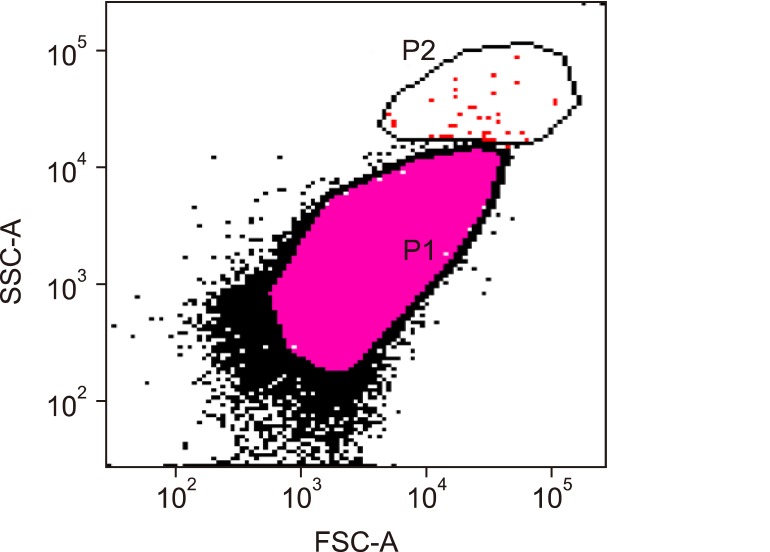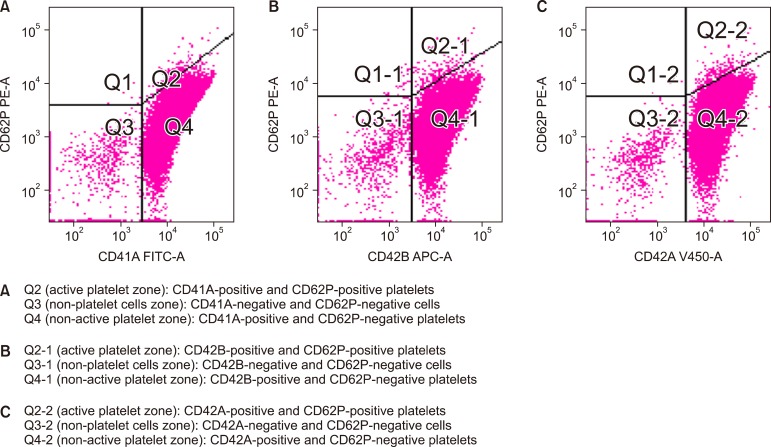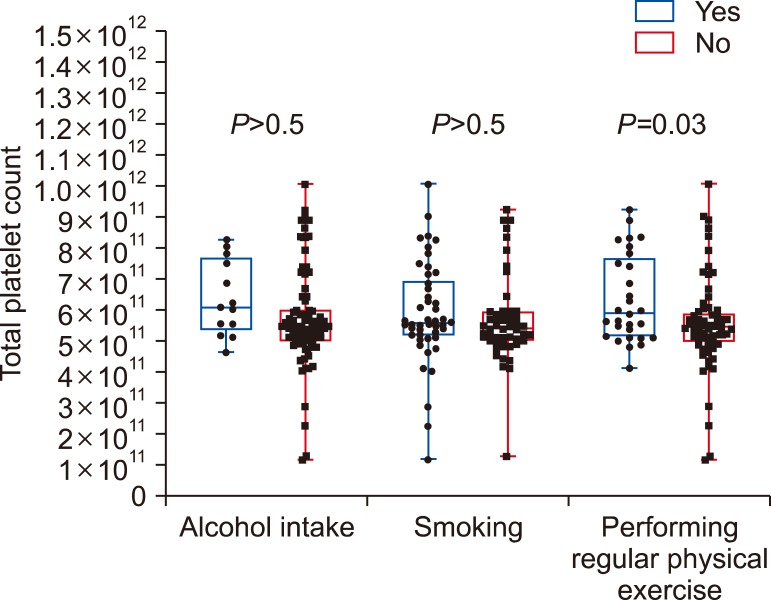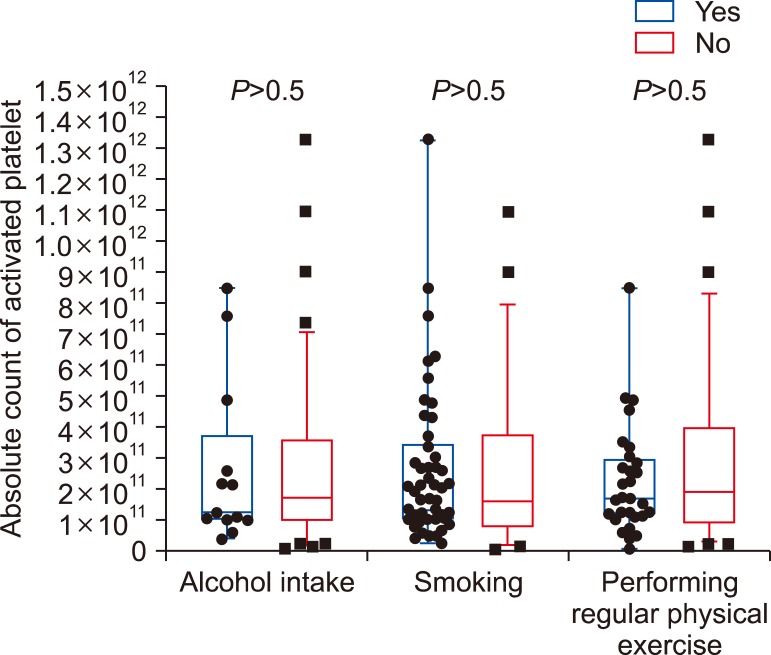Blood Res.
2019 Dec;54(4):262-268. 10.5045/br.2019.54.4.262.
Evaluating the effect of donor anxiety levels and lifestyle characteristics on the activation of platelet concentrates
- Affiliations
-
- 1Regional Blood Center, Health Science University, Gulhane Training and Education Hospital, Ankara, Turkey. drsoneryilmaz@gmail.com
- 2Department of Pediatric Hematology, Afyon Kocatepe University, Afyon, Turkey.
- 3Department of Hematology, Health Science University, Gulhane Training and Education Hospital, Ankara, Turkey.
- 4Department of Allergy and Immunology, Health Science University, Gulhane Training and Education Hospital, Ankara, Turkey.
- 5Department of Infectious Disease, Health Science University, Sultan Abdulhamid Han Training and Education Hospital, Istanbul, Turkey.
- 6Department of General Surgery, Health Science University, Gulhane Training and Education Hospital, Ankara, Turkey.
- 7Clinical Research International Ltd, Cologne, Germany.
- 8Department of Infectious Disease and Clinical Microbiology, Health Science University, Gulhane Training and Education Hospital, Ankara, Turkey.
- KMID: 2466591
- DOI: http://doi.org/10.5045/br.2019.54.4.262
Abstract
- BACKGROUND
Smoking, alcohol use, performing regular physical exercise, dietary habits, and anxiety level may cause platelet activation. We aimed to evaluate the anxiety levels, smoking status, alcohol intake, and sportive habits of donors, and determine their impact on the quality of apheresis-platelets.
METHODS
State and Transient Anxiety Inventory (STAI) was used to determine the level of donors' anxiety. STAI has two subscales: S-anxiety scale (STAI-I) and T-anxiety scale (STAI-II), each comprising 20 questions rated on a 4-point Likert scale. Data on smoking, alcohol consumption, and performing regular physical exercise were obtained from a questionnaire filled out before donation. Flow cytometric analysis was used to quantify activated platelets.
RESULTS
The STAI-I level of 86 participants was normal, while that of 12 was higher. No significant difference was found in the active platelet absolute count [1.8×10¹¹ (2.7) and 1.4×10¹¹ (1.3), respectively; P=0.665] between donors with normal STAI-I levels and those with higher STAI-I levels. Of 98 donors, 42 had normal STAI-II levels, while 56 had higher STAI-II levels. No significant difference was found in the active platelet absolute count [2.3×10¹¹ (3.1) and 1.5×10¹¹ (2.3), respectively; P=0.224] between donors with normal STAI-II levels and those with higher STAI-II levels. Platelet counts of individuals who perform regular physical exercise were significantly higher than those of individuals who did not perform regular physical exercise (6.3±1.4×10¹¹ vs. 5.5±1.4×10¹¹).
CONCLUSION
The quality of apheresis platelets is not affected by anxiety levels and lifestyle characteristics of blood donors. There is no need to organize apheresis blood donor pool considering with these subjects.
MeSH Terms
Figure
Reference
-
1. Yin G, Xu J, Shen Z, Wang Y, Zhu F, Lv H. The relationship of platelet yield, donor’s characteristic and apheresis instruments in China. Transfus Apher Sci. 2013; 49:608–612. PMID: 23978555.
Article2. Scheinichen D, Heuft HG, Renken C, et al. Impact of tobacco smoking on platelet function in apheresis products in vitro. Vox Sang. 2004; 86:252–256. PMID: 15144530.
Article3. Koudouovoh-Tripp P, Sperner-Unterweger B. Influence of mental stress on platelet bioactivity. World J Psychiatry. 2012; 2:134–147. PMID: 24175179.
Article4. Ringwald J, Lange N, Rabe C, et al. Why do some apheresis donors donate blood just once? Vox Sang. 2007; 93:354–362. PMID: 18070281.
Article5. Trimmel M, Lattacher H, Janda M. Voluntary whole-blood donors, and compensated platelet donors and plasma donors: motivation to donate, altruism and aggression. Transfus Apher Sci. 2005; 33:147–155. PMID: 16115800.
Article6. National Blood and Blood Components Preparation, Use and Quality Assurance Guide. Ankara, Turkey: Turkish Ministry of Health;2015. Accessed February 17, 2019. at http://www.shgm.saglik.gov.tr/TR,9968/ulusal-kan-ve-kan-bilesenleri-hazirlama-kullanim-ve-kalite-guvencesi-rehberi.html.7. World Health Organization. Fact Sheet: Physical activity. Geneve, Switzerland: World Health Organization;2018. Accessed January 21, 2019. at https://www.who.int/news-room/fact-sheets/detail/physical-activity.8. Global Adult Tobacco Survey Collaborative Group. Global Adult Tobacco Survey (GATS): core questionnaire with optional questions, version 2.0. Atlanta, GA: Centers for Disease Control and Prevention;2010.9. Ögel K, Tamar D, Özmen E, et al. The frequency of alcohol consumption in Istanbul. Istanbul, Turkey: Kültegin Ögel's Blog;2003. Accessed January 21, 2019. at http://www.ogelk.net/Dosyadepo/istanbul_alkol_yayginlik.pdf.10. Spielberger CD, Gorsuch RL, Lushene R, Vagg PR, Jacobs GA. The State-Trait Anxiety Inventory (STAI). Palo Alto, CA: Consulting Psychologists Press;1983.11. Balsamo M, Romanelli R, Innamorati M, Ciccarese G, Carlucci L, Saggino A. The State-Trait Anxiety Inventory: shadows and lights on its construct validity. J Psychopathol Behav Assess. 2013; 35:475–486.
Article12. Julian LJ. Measures of anxiety: State-Trait Anxiety Inventory (STAI), Beck Anxiety Inventory (BAI), and Hospital Anxiety and Depression Scale-Anxiety (HADS-A). Arthritis Care Res (Hoboken). 2011; 63 Suppl 11:S467–S472. PMID: 22588767.
Article13. Oluk S, Ozuredi O, Sakaci T. Determination of state-trait anxiety levels of university students during the learning process of global environmental problems. US-China Education Review. 2009; 6:49–53.14. Sevindik CS, Yilmaz MF, Erden SC, Kolat E, Akdeniz M. Is Monday a syndrome? Journal of Mood Disorders. 2014; 4:152–156.
Article15. Ahmed N. Quality management procedure of platelet concentrate. Ind J Transfus Med. 2016.16. Gutensohn K, Bartsch N, Kuehnl P. Flow cytometric analysis of platelet membrane antigens during and after continuous-flow plateletpheresis. Transfusion. 1997; 37:809–815. PMID: 9280325.
Article17. Heber S, Volf I. Effects of physical (In)activity on platelet function. Biomed Res Int. 2015; 2015:165078. PMID: 26557653.
Article18. Mukamal KJ, Massaro JM, Ault KA, et al. Alcohol consumption and platelet activation and aggregation among women and men: the Framingham Offspring Study. Alcohol Clin Exp Res. 2005; 29:1906–1912. PMID: 16269922.
Article19. Miyamoto S, Kawano H, Sakamoto T, et al. Formation of platelet microaggregates correlates with adverse clinical outcome in patients with coronary artery disease. Thromb Haemost. 2003; 89:681–686. PMID: 12669123.
Article20. Kabbani SS, Watkins MW, Ashikaga T, Terrien EF, Sobel BE, Schneider DJ. Usefulness of platelet reactivity before percutaneous coronary intervention in determining cardiac risk one year later. Am J Cardiol. 2003; 91:876–878. PMID: 12667577.
Article21. Powell KE, Thompson PD, Caspersen CJ, Kendrick JS. Physical activity and the incidence of coronary heart disease. Annu Rev Public Health. 1987; 8:253–287. PMID: 3555525.
Article22. Singh I, Quinn H, Mok M, et al. The effect of exercise and training status on platelet activation: do cocoa polyphenols play a role? Platelets. 2006; 17:361–367. PMID: 16973496.
Article23. Alexander RW, Cooper B, Handin RI. Characterization of the human platelet alpha-adrenergic receptor. Correlation of [3H] dihydroergocryptine binding with aggregation and adenylate cyclase inhibition. J Clin Invest. 1978; 61:1136–1144. PMID: 207726.24. Weksler BB, Nachman RL. Platelets and atherosclerosis. Am J Med. 1981; 71:331–333. PMID: 7025618.
Article25. Mest HJ, Zehl U, Sziegoleit W, Taube C, Forster W. Influence of mental stress on plasma level of prostaglandins, thromboxane B2 and on circulating platelet aggregates in man. Prostaglandins Leukot Med. 1982; 8:553–563. PMID: 6955811.
- Full Text Links
- Actions
-
Cited
- CITED
-
- Close
- Share
- Similar articles
-
- Incidence of Red Blood Cell Alloantibody Formation after Platelet Concentrate Transfusions
- Platelet Activation of Stored Platelets with Storage
- Effects of Cytokine on Platelet Activation
- Clinical Experience in Treatment of Diabetic Foot Ulcers Using Platelet Concentrates from Blood Bank
- Effect of Platelet Transfusion on the Platelet Parameters of Recipient





